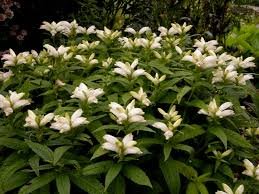Turtlehead
(4” pot) - chelone glabra - A fall blooming perennial, turtlehead gets its common name from the blossoms that resemble the shape of a turtle’s head with its mouth partly open. The genus name comes from Chelone, a nymph in Greek mythology who was punished for by the gods by turning her into a turtle. The plants are also occasionally referred to as shellflowers. Typically found in bogs, swamps, along streams or in moist woods. Turtlehead is native to Vermont, deer resistant, and a good pollinator. It will grow to aprox. 2.5’ high x 2’ wide, with white flowers, liking moist soil, sun and part shade.
Zone 4
(4” pot) - chelone glabra - A fall blooming perennial, turtlehead gets its common name from the blossoms that resemble the shape of a turtle’s head with its mouth partly open. The genus name comes from Chelone, a nymph in Greek mythology who was punished for by the gods by turning her into a turtle. The plants are also occasionally referred to as shellflowers. Typically found in bogs, swamps, along streams or in moist woods. Turtlehead is native to Vermont, deer resistant, and a good pollinator. It will grow to aprox. 2.5’ high x 2’ wide, with white flowers, liking moist soil, sun and part shade.
Zone 4
(4” pot) - chelone glabra - A fall blooming perennial, turtlehead gets its common name from the blossoms that resemble the shape of a turtle’s head with its mouth partly open. The genus name comes from Chelone, a nymph in Greek mythology who was punished for by the gods by turning her into a turtle. The plants are also occasionally referred to as shellflowers. Typically found in bogs, swamps, along streams or in moist woods. Turtlehead is native to Vermont, deer resistant, and a good pollinator. It will grow to aprox. 2.5’ high x 2’ wide, with white flowers, liking moist soil, sun and part shade.
Zone 4

